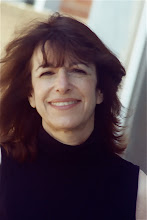 I've just returned from a trip to London and Paris -where I had the great pleasure of meeting and wining and dining with Doug Cushman, the wonderful illustrator of Tyrannosaurus Math. Quel plasir!
I've just returned from a trip to London and Paris -where I had the great pleasure of meeting and wining and dining with Doug Cushman, the wonderful illustrator of Tyrannosaurus Math. Quel plasir! So this is my first blog post for April- which happens to be Math Awareness Month. To mark the occasion, TC & TF asked author Loreen Leedy some questions about the writing of Missing Math.
1. What was the inspiration for Missing Math? Did it start with a concept, or an image, or...?
The initial impulse for Missing Math is unfortunately lost in the mists of time. It may have been the play on words of "number cruncher" being someone who works with numbers vs. a character who eats numbers. I generally work back and forth between scribbled words and doodles that may not end up in the final book but that are part of the process of one idea leading to another one until THE idea arises that I feel inspired to keep developing. Though the "number cruncher" character didn't end up in the final book, he got things rolling.
2. How long did it take to complete the winning manuscript? What types of changes were made (point of view, age level, etc) and why? What can writers learn from your experience with this manuscript?
I worked on the basic idea of math disappearing off and on for about 8 years, creating at least four picture book versions plus a chapter book. My editor liked the basic concept but kept rejecting each manuscript/dummy, then later would bring it up again. The only reason I kept trying was that the idea fascinated me, how pervasive math and numbers are in everyday activities from cooking to buying things to making a phone call, yet we rarely think about it. Just as an artist has to sketch out an idea to see how it looks, an author has to actually write up a story to see whether it will work or not. What writers could learn from my slog is that there are many possible ways to give expression to an idea, and you may have to spend time in dead ends before you get to drive onto the freeway(!)
3. What was the most challenging aspect of writing the book?
Getting so many rejections for the same basic idea, then starting over again. At least my list of possible numbers/math scenarios came in handy for every revision (sports scores, money, postal addresses, speed limits, shoe and clothing sizes, telling time, etc.)
4. How would you like teachers and parents to use the book?
My math education was quite sterile and disconnected from any sense of real life... my hope is that teachers and parents can use my books to create a true appreciation of math and numbers, especially in children who find the topic puzzling or intimidating.
Loreen, I'm in total agreement! Thanks for sharing your writing process with us.
__________________________________________________________________








I'm a big fan of books that can present the idea of a math concept simply and with an interesting storyline. This book sounds like a winner!
ReplyDeleteKim
Loreen is also a wonderful illustrator. She redesigned the entire book concept 3 or 4 times before finally getting the winning approach. Thanks Michelle for this wonderful interview. It also illustrates the great benefit of working closely with, and listening to, the editors that we have established a relationship with.
ReplyDeleteThank you for interviewing me for your blog, Michelle!
ReplyDelete